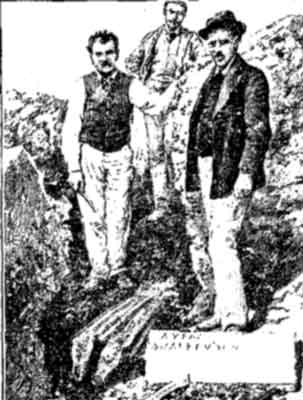.
Griechische Kunst : Zeitlinie
6000-5000 BC Stone Idol from Sparta, Neolithic period

3300-2000 BC Early Cycladic Civilization
3300-2800 BC Civilization of Grotta-Pylos, 2800-2300 Keros-Syros, 2300-2000 Phylakopi I Phase 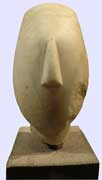
Head from Keros (Cyclades) 2700-2300 BC
2000-1700 BC Middle Bronze Age
1900 BC construction of Palaces of Knossos, Malia and Kato Zakros
Achaeans enter in Greece. c. 1700, destruction of palaces by earthquakes
2000-1600 BC Middle Cycladic Period
1700-1100 BC Late Bronze Age
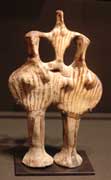
Phi - figurines, Louvre MNE 1007
Minoan (from 3000 BC until 1400 BC with catastrophic events around 1700 and 1450 BC and Mycenean invasion around 1400). Since 1500 Mycenean civilization.
1600 – 1100 BC Late Cycladic Period
1700-1450 BC
Neopalatial period after restoration of destroyed palaces in Knossos
1450-1100 BC
Postpalatial period with Mycenean influence

1350 BC, Goddess with Poppy-headed Pins
1100-850 BC Dark Age
1000 - 900 BC
Protogeometric pottery, Decoration with black bands, wavy lines and simple geometric designs, concentric and half circles
?? BC
“Daidalos the son of Eupalamos, son of Etion and Alkippe, made [this] labyrinth. He was the best builder and the first inventor of statues” according to Apollodoros Bibliotheca, 1st Century AD. --- “he was the first to represent the eyes open and the legs separated as they are in walking, and also to render the arms and hands as if stretched out ... For the artists who preceded him used to make their statues with the eyes closed, and with the arms hanging straight down and attached to the ribs.”according to Diodorus
Chronology and Terminology Details of the Periods and Terminology from The Prehistoric Archaeology of the Aegean Website. Actually not all experts agree on the dates, which are only approximations.
Geometric Period (900-700 BC)
900 - 700 BC
c. 700 - 650 BC
Invention of the sphyrelation technique, creation of large bronze statues by nailing hammered sheets of bronze onto a wood core. (Dreros Group, Apollo, Artemis and Leto, Crete). Probably first introduced in Samos.
Geometric pottery, Early Geometric (EG, 900-850), middle Geometric (MG, 850-760) and late Geometric (LG, 760-700), Increasing variety of rectilinear ornaments (meander, “battlements”, triangles, hatching etc.) cover a larger portion of the pot; simple figures of animals and human bngs - reduced to geometric forms
c. 630 BC

The Lady of Auxerre, Daedalic style, after the legendary Daidalus (the skillful one). Probably from Crete
c. 610 BC
Athenian black-figure pottery until 520-510
700 - 500 BC
Archaic pottery Orientalizing (700-600) BC: Style with elements from older civilizations of the Near East; (decorative animal and floral forms) early experiments with the incised black-figure technique and with polychrome (multi-colored) decoration; in various Greek centers experiments with narrative representations of myths and legends. Exekias, Andokides, Euthymides, Kleitias. Sir John Beazley defined and cataloged thousands of Attic Black-figure vases using information available such as painter, style or workshop origin
Archaic Period (600-480 BC)
6th century BC
Tektaios and Angelion 8 m large Apollo of Delos covered with gold
Telekles and Theodoros, sons of Rhoikos, (Egyptian influence) (statue of the Pythian Apollo, Samos)
Kanachos bronze Apollo Philesios (Pliny, NH 34.75 ), Aphrodite in Sicyon (Paus. 2.10.4)
c. 580 BC

c. 580 BC
Dipoinos and Skyllis, students (and sons?) of Daidalus, Sicyon school of sculpture
c. 570 BC

The Moschoforos (Calf bearer) a work probably of Phaidimos
c. 566 BC
One of the earliest known Panathenaic amphorae, The Burgon vase
c. 550 - 520 BC

Statue of Kouros of Tenea, Corinth
c. 550 - 520 BC
Period of Aristion, archaic kore statue
c. 540 - 500 BC
Period of Antenor, marble, bronze
c. 530 BC
Peplos Kore statue from the Acropolis, Athens.
c. 530 - 500 BC
Period of Endoios, marble, Seated Athena
c. 525
Red Figure Pottery in Athens, Siphnian Treasury Delphi
Another sculpture produced 100 years earlier and covered with gold was the probably 8 m large Apollo of Delos, a work of Tektaios and Angelion.
c. 500 - 480 BC
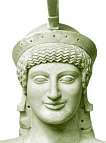
Aphaia Temple Pediment statues (around 480 BC new East pediment)
Classic Pottery: 500 - 323 BC, Euphronius (Archaic to Classic), Kleophrades, Brygos, Kleophon
Ageladas (or Hageladas) of Argos, flourished late 6th and early 5th centuries BC, probably teacher of Polykleitos of Argos, Myron of Eleutherai and Pheidias , Herakles Alexikakos statue, Zeus Ithomatas, Zeus Pais, Youthful Herakles.
c. 500 -450 BC
Kallon of Aigina student of Tektaios and Angelion
5th century
Anaxagoras of Aigina, sculptor, Zeus statue near the Bouleuterion (Pausanias)
Early (transitional and severe) and High Classical Style (480-400 BC)
480 - 460 BC
Period of Critius (or Kritios) and Nesiotes Critius Boy, Charioteer of Motya , Tyrannicides, a bronze group that depicted Harmodios and Aristogeiton
c. 478 - 474 BC

The Charioteer of Delphi, Sotades.
2nd half of 5th century BC
Colotes (or Kolotes). Helped Pheidias on the statue of Zeus at Olympia; statues of philosophers. Material chryselephantine; bronze
c. 490 - 430 BC
Period of Pheidias , son of Charmides, bronze, marble and chryselephantine, Athena Promachos on the Acropolis at Athens; an Amazon at Ephesus; Athena for the Parthenon; Zeus at Olympia (Most famous sculptor in antiquity; also an architect and painter). Students of Pheidias: Alkamenes, Agorakritos of Paros, Colotes assistant in the making of the Zeus at Olympia
470 - 430 BC
Working period of Calamis, Zeus Ammon; statue of Apollo; Asclepius in Sicyon; Sosandra on the Acropolis at Athens. Material used bronze, marble, gold, ivory, chryselephantine.
460 - 450 BC

The first Riace warrior (Bronze or Statue A)
c. 460
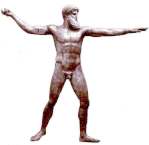
Poseidon (some say Zeus) of Artemision in the National Museum of Athens. Probably a work of Kalamis
c. 460 - 430 BC
Period of Myron of Eleutherai, bronze and marble, Discus thrower; Athena and Marsyas; a cow on the Acropolis at Athens. Teacher of his son Lykios another sculptor.
2nd half of 5th century
Period of Polycleitus, bronze, marble, gold, ivory, chryselephantine. Doryphoros; Diadoumenos; statue of Hera at Argos; athletes at Olympia. Wrote a book on rhythm and proportion. Students of Polycleitus according to Pliny: Alexis, Argeios, Asopodoros, Athenodoros, Damias of Kleitor, Deinon and Phrynon
c. 450 BC
Athena Lemnia, on the Acropolis, Pheidias

Discobolos (Discuss Thrower), bronze sculpture by Myron
Chiaroscuro, 3-dimensional painting technique, by using highlighting and shadowing.
c. 450 - 440 BC

The Doryphoros or Canon, Polykleitos (or Polycleitus) of Sicyon,
Dying Daughter of Niobe, Rome Museo Nazionale. Found on the Esquiline, Rome
450 - 430 BC
Period of Cresilas, statue of Pericles and wounded Amazon
447 - 432 BC
Parthenon (complete 438 with decorations added until 432), 437-432 Propylaia (Mnesikles)
440 - 400 BC
Period of Alcamenes, Statue of Dionysus, an athlete, Hermes of the Gateway. Material marble, bronze, gold ivory and chryselephantine, probably work for Parthenon for Pheidias
Period of Agoracritus, a favorite student of Pheidias, marble and bronze, Statues of Nemesis at Rhamnus, the Mother of the Gods at Athens
Late Classical Period (4th century BC, 430-323 BC)
c. 430 - 420 BC

The second Riace warrior with a helmet (Bronze B or Statue B).
Diadoumenos statue, Polycleitus
c. 425 BC
Paeonius of Mende, Statue of Nike of Paeonius, marble

Aphrodite of Knidos (Cnidos or Cnidus) Praxiteles
380 - 340 BC
Working period of Timotheus, temple of Asclepius at Epidaurus and Mausoleum at Halicarnassus
c. 380 - 325 BC
Period of Praxiteles
Statues of Aphrodite; Apollo; Apollo Sauroctonus; Satyrs; Artemis; Eros; Dionysus, Phryne; Hermes with Dionysus. Material bronze, marble. One of the most known Greek artist. Only 1 original statue, and part of a bas-relief probably executed under his direction. Literature describes around 50 statues of Praxiteles.
c. 375 - 370 BC

Cephisodotus (or Kephisodotos the Elder’s) perhaps the father of Praxiteles, Eirene & Ploutos (bronze?). Statue group erected in the Agora, Athens
370 - 330 BC
Period of Euphranor of the Isthmus of Corinth, Philip II and Alexander the Great riding in chariots; statue of Paris, cult statue of Apollo Patroos, all in Athens. Also a painter and treatise writer on colours and symmetry.
4th century BC
Scopas (or Skopas) of Paros, marble , around thirty statues distributed in Greece proper and on the coast of Asia Minor, architect of a temple of Athena at Tegea in Arcadia which was built to replace one destroyed by fire in 395-4. He as active as late as the middle of the century, being one of four sculptors engaged on the reliefs of the Mausoleum or funeral monument of Maussollus, satrap of Caria. Statues all representing divinities or other imaginary beings mentioned in literature but only the Maenad statue survived.
Silanion of Athens, bronze , Statues of Achilles, Theseus, Dying Jocasta, Sappho, Corinna, Plato, Apollodorus, three boxers. (Wrote on the rules of proportion)
c. 353 - 350 BC
Death of Mausolus ( King of Halikarnassos) Aspasia builds the "Mausoleum" with sculptures by Scopas, Bryaxis, Timotheos, and Leochares
c. 344 - 333 BC
Daochos Monument, Lysippos Delphi
c. 343 - 330 BC

Hermes and Dionysos, Praxiteles
c. 340 BC

The Ephebe (Young man) of Antikythera, bronze statue, called also “The Ball Player”, or “Paris”, created in Polycleitus tradition. Many think that it is the work of Kleon of Sicyon or a work of Euphranor.
c. 330 BC

Apoxyomenos by Lysippus (or Lysippos) of Sicyon. Probably worked during the reign of Alexander (336-23). Thus he belongs to the generation succeeding that of Scopas and Praxiteles.
c. 330 - 325 BC

The Ephebe (Young man, maybe Hermes) from Marathon.
323-44 BC Hellenistic Period
c. 320 BC
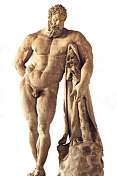
The Farnese Hercules, bronze original by Lysippos.
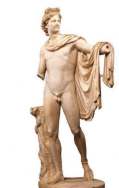
Apollo Belvedere from the Athenian artist Leochares who worked for Alexander the Great
c. 317 BC
Demetrios of Phaleron's passed a law that prohibited the erection of elaborate stelai.
Themis by Cheirestratos
3rd century BC
Eutychides of Sicyon, sculptor and painter, student of Lysippus, Tyche of Antioch “seated on a rock, with the Orontes River at her feet”
Kantharos of Sicyon, student of Eutychides, sculpture of the wrestler Cratinus of Aegeira
c. 280 – 250 BC
Xenocrates of Sicyon, sculptor, painter, student of Eythycrates the son of Lysippus. According to Pliny Author of the books De Toreutice and De Pictura
228 BC
Dying Gaul and his Wife, Galatian monument by Attalos I
c 200-150 BC
Period of Damophon, Cult statues in Peloponnese; repaired statue by Pheidias of Zeus at Olympia
2nd c. BC
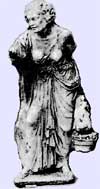
Old Market Woman
c. 190 BC
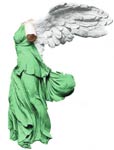
Nike of Samothrace by Pythokritos of Rhodes
c. 150 BC bronze original?
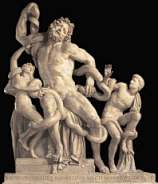
Marble copy produced by the three sculptors
1)Athanadoros son of Hagesandros,
2) Hagesandros son of Paionios
3) Polydoros son of Polydoros of Rhodes
The Laocoon Group and Sperlonga sculptures by
166 - 156 BC
Altar of Zeus in Pergamon East, South, North, West Frieze, a work of up to 40 sculptors with 15 signatures found.
150 - 100 BC

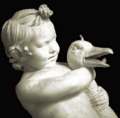
Boy with Goose, Boethus (or Boethos) of Chalcedon
c. 130 - 120 BC?

Aphrodite of Melos (Venus de Milo) sculpture from Alexandros of Antioch, son of Menides,
The Apotheosis of Homer relief produced by Archelaos , the son of Apollonius of Priene
c. 120 BC?
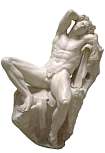
The sleeping Satyr, (Barberini Faun), Munich Glyptothek, sculptor unknown
140 - 120 BC?
Period of Eubulides the Younger, Colossal group of Athena, Zeus, Mnemosyne, the Muses, and Apollo at Athens
Son of sculptor Euchior and grandson of sculptor Eubulides the Elder

Belvedere Torso, 2nd -1st century BC, Apollonius the son of Nestor from Athens, Citta del Vaticano, Sala delle Muse
First Century BC
Agasias of Ephesus, son of Dositheus, Sculptor of The Borghese Gladiator, now in the Louvre.
Agasias of Ephesus, son of Menophilus, Sculptor of a warrior in the museum of Athens.
170 - 180 AD
Pausanias provides important information about pieces of Art he has seen in various cities in his book Description of Greece
1506
The Laocoon sculpture was found in Rome on January 14, 1506 near the site of Neros Domus Aurea or 'Golden House'
1540
Discovery of The Farnese Hercules in the Baths of Caracalla in Rome
1611
Discovery of The Borghese Gladiator at Nettuno near Anzio in 1611. By 1613 it was in the Borghese collection. In 1807 it was purchased by Napoleon.
1674
Jacques Carrey, a French artist spents two weeks making sketches and drawings of the Parthenon that provide an idea of the building as it was before the almost complete destruction.
1764
Johann Joachim Winckelmann ( born 9. 12. 1717 Stendal/Germany – 8.6.1768 / killed in Trieste by Francesco Arcangeli ) writes the influential book: Geschichte der Kunst des Altertums (History of Art of Antiquity). He never visited Greece (that may explain his idealism).
1811
Discovery of the Aphaia temple sculptures (Aegina ) by the english architects C.R. Cocharel and John Foster together with Baron Haller von Hallerstein. King Ludwig buys the sculptures that are today in the Glyptothek in Munich/Germany. Later Restoration in Italy under the superintendence of the Danish sculptor Thorwaldsen
1820
Discovery of Aphrodite of Melos (Venus de Milo) on the island of Melos one of the Cyclades islands
1849
Apoxyomenos, Roman marble copy found 1849 in the Trastevere district of Rome.
1863
Discovery of the Nike of Samothrace , the basis of the Nike, a ship's prow, was found in 1875
1864
Discovery of The Moschoforos (Calf bearer) in Athens
c. 1870
Discovery of “Tanagra” terracotta figurines
1875
20 -21 December discovery of the Nike of Paeonios and its pedestal
8th May 1877
Hermes and Dionysos by Praxiteles found at the Hera temple now at the museum of Ancient Olympia.
1894
Discovery of the kouroi Kleobis and Biton and a statue of Antinoos in Delphi
1900
a disgruntled museum guard threw a stool at the case and smashed the François Vase to 638 pieces. It was restored in by Pietro Zei, incorporating the Strozzi fragment, but missing another piece which had been stolen. That piece was returned in 1904. A new reconstruction was performed in 1973.
1903
Discovery of the Snake Goddess by Arthur Evans in the Temple Repositories in Knossos, Crete
1926
Discovery of The Ephebe (Young man, maybe Hermes) from Marathon found at the Marathon bay and the young Jockey of Artemision
1928
Discovery of Poseidon (or Zeus) of Artemision in a shipwreck at Cape Artemision.
1958
archaeologists found the workshop of Pheidias at Olympia (the place where the colossal gold ivory Zeus statue was produced. A bronze drinking cup was found with the inscription "I belong to Pheidias."
1959
Discovery of a Athena statue made in 340-330 BC by Kephisodotos during road construction works in Piraeus. Also found the Apollo of Peiraeus statue, a marble statue of Artemis,a mask, a shield, etc.
1961
Discovery of the archaic Mykonos vase with an illustration of the Trojan horse
1967 - 1973
Excavations at Thera, Santorini (Minoan city of “Akrotiri”) by Spyridon Nikolaou Marinatos (4-11-1901 – 1-10-1974)
August 1972
Discovery of the two Riace warriors from the sea off coast of southern Italy (Calabria) near the village of Riace
1979
Discovery of Charioteer of Motya in Motya, Sicily
1981
Discovery of Kouros of Samos
1999
Discovery of the original bronze Apoxyomenos in the sea close to Lošinj, a Croatian island.
2002
Discovery of a new Dipylon Kouros
2004
http://www.novinite.com/view_news.php?id=39590 A bronze sculpture in Bulgaria found could be the work of Pheidias
Reports in German
Antikenrezeption in Griechenland
Deborah Tarn Steiner , Images in Mind: Statues in Archaic and Classical Greek Literature and Thought Princeton University Press 2001
| Ancient Greece
Science, Technology , Medicine , Warfare, , Biographies , Life , Cities/Places/Maps , Arts , Literature , Philosophy ,Olympics, Mythology , History , Images Medieval Greece / Byzantine Empire Science, Technology, Arts, , Warfare , Literature, Biographies, Icons, History Modern Greece Cities, Islands, Regions, Fauna/Flora ,Biographies , History , Warfare, Science/Technology, Literature, Music , Arts , Film/Actors , Sport , Fashion --- |

